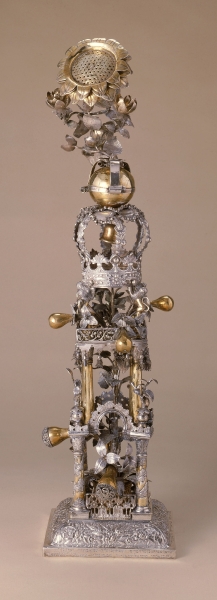SPICE CONTAINER MADE IN BERDICHEV
(Courtesy: The Jewish Museum)
 |
Spice Container
Berdichev ), Russian Empire,
1810-20
|
The extraordinary form of this spice container combines two types: the tower that had been traditional in the West since the Middle Ages and the fruit-form container that became popular in Eastern Europe from the 18th century on. In a tour-de-force composition, the silversmith made the multistoried tower into a frame for "growing" plants. Linking the two forms are the many repoussé floral motifs that decorate the base and the other architectural elements.
Though the source of the tower-form spice container in the medieval censer tradition is known, the basis of the second type, the fructiform container, has never been established. Its appearance in Poland during the 18th or 19th centuries may represent another instance of Middle Eastern influence on East European decorative arts and on Judaica in particular. During the 16th century, the Ottoman Empire reached its apogee in terms of territorial conquest. In Europe, the sultans controlled the Balkan peninsula and portions of the lands now belonging to Hungary, Czechoslovakia, and Austria. As a result, new genres, techniques, and compositions became part of the artistic heritage of middle Europe, the area from which most Jews immigrated to Eastern Europe. In the 18th century, long after the Ottoman expulsion from Europe, artistic influence flowed from Turkey as the result of trade and an exchange of workers. Turkish weavers labored in Polish factories producing fabrics that were incorporated into Jewish ceremonial objects or that influenced their design; this was part of the "Turkomania" that seized Europe in general. It is tempting to see in the parallels between Turkish fructiform containers and those from Eastern Europe another instance of cross-cultural influence.
A lengthy, engraved inscription covers the base and the bottom of the sunflower. It records the twenty male donors whose names are inscribed in an unusual matrilineal form. This spice container came in a leather case inscribed "the year [5]515 (=1855/6) from Berdichev." The date of this inscription is now partially obliterated. In any case, the spice container may have been made some thirty years earlier. The distinctive cast lions that hold aloft the crown appear on a series of Torah crowns in various collections that date from1806-19.
Berdichev was the home of the Hasidic rebbe (rabbi) Levi Isaac (ca. 1740-1810), the founder of Hasidism in central Poland. The matrilineal names engraved on this spice container may reflect the Hasidic custom of using the mother's name on written, personal requests to the rebbe.